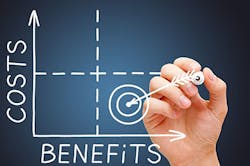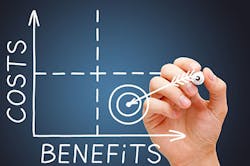Calculate Your Cost to Sell to a New vs. Existing Customer
For decades, HVAC contractors and others wrestled with how to quantify the difference between selling to new or existing customers. Many sources suggest it costs five times more to acquire a new customer than to keep an existing one. Also, standard sales rules-of-thumb say the odds of making a sale to new customers are less than 20% compared to a 60% chance of success when selling to an existing customer.
Let's look at how you can easily calculate your cost to sell to a new customer versus one you already have. We'll then talk about how you can use this information to examine your sales team's habits and unaccounted results.
The goal of this exercise is to help you attach dollar values to your sales efforts. These dollar values provide a better picture of where to focus on increasing your sales success.
Find Your Company's Cost per Proposal
To keep this simple, we'll look at the theoretical sales team of "Heat Masters" (HM). This HVAC sales team sells equipment replacement and system upgrades only. They are a high-end shop with an average sales price of about $16,000.
HM's general manager set out to discover a new, fresh way to guide his sales team's work and greatly increase their results. To calculate HM's average cost to deliver a proposal required three hidden financial statistics.
1. Annual marketing expense.
2. Total annual cost of operating the sales team.
3. Number of proposals made and jobs sold in a typical year.
HM's annual retrofit and system upgrade sales average $2 million per year. This year's annual marketing costs are around $60,000, which is 3% of sales. This percentage is a typical marketing expense for our industry.
After studying HM's profit and loss statements, the general manager discovered the annual cost to operate his sales team is $240,000. This cost includes the entire sales team's salaries, benefits, commissions, training, vehicle costs, and related expenses. Combining the marketing and sales team operation costs shows HM's total annual cost of making sales is $300,000.
Next, the General Manager found that his sales team delivered an average of 500 proposals per year. He divided the $300,000 in total sales costs of 500 proposals per year to reveal each one cost $600 to deliver.
Next, Calculate Sales Closing Rate
The general manager of Heat Masters guessed his team typically sold 4 out of 10 jobs but hadn't tracked company and individual closing rates carefully. To look beyond HM's cost per proposal, he needed to gather individual salesperson information and calculate and track sales closing rates.
He found that 125 sales resulted from 500 proposals. To find the sales closing rate, the general manager divided 125 sales by 500 proposals. (125 ÷ 500 = .25) That means HM's sales closing rate was 25%. While their closing rate is a little higher than the industry's average, it is much lower than the 40% they guessed it was. Ouch!
Calculate the Cost to Sell to a New Customer
If the general rule is that it costs five times more to acquire a new customer than it does to keep an existing one, then how do you find out what your total costs for a new customer are?
By reviewing their sales statistics, HM's general manager confirmed the odds of making a sale to a new customer averaged only 15%. This percent was surprising and became a call to action.
He calculated HM's average cost to sell to a new customer by dividing the $600 proposal cost by their 15% new customer closing rate.
Here's the math:
Proposal cost of $600 ÷ Sales closing rate of 15% (or .15) = HM's sales cost to a new customer of $4,000.
That $4,000 cost to sell each job to a new customer was much higher than the general manager thought it was. This discovery confirmed HM's low new customer sales closing rate and perhaps the need to slow down and build stronger relationships with existing customers. This new information made the GM wonder if HM's prices were too high, causing low sales closing rates.
You may discover that you base many decisions on guesses rather than an accurate assessment of your sales team.
Will your company's results be as shocking as HM's? Please take a few hours to gather your sales information and find out for yourself. As HM's did, you may discover that you base many decisions on guesses rather than an accurate assessment of your sales team.
Now, Calculate the Cost to Sell to an Existing Customer
As HM's general manager evaluated its sales numbers, he discovered their sales closing rate for existing customers was 65%.
He calculated their average cost to sell to an existing customer using the same formula. He divided their $600 cost per proposal by their existing customer closing rate of 65% to discover it only costs $923 to sell to an existing customer!
In other words, selling to an existing HM's customer costs only 25% of selling to a new customer.
The general manager dug deeper and learned only 30% of their sales were to existing customers and 70% of their sales were to new customers. This discovery was far different than what he assumed. These two percentages told a story and begged the question: Did the focus to expand the company outweigh their need to care for existing customers?
Immediately, the general manager developed an entirely new vision of where the sales team should go. These hidden realities caused the company to stumble in the dark. HM's and their sales team shifted their focus to serving and keeping existing customers. Things would never be the same again.
They, like you, must seek this information. You need to calculate your sales statistics before you can know how to make sales team improvements.
What's Hidden in Your Financials?
Few companies calculate their cost to sell jobs by comparing the cost of selling to new versus existing customers. If you felt a twinge of concern as you read the discoveries of HM's, please take a few hours, study your profit and loss statements, and rally your sales team to extract and calculate this information.
The primary value of this process is to help you make clear, effective decisions. Good decisions drive the changes that will improve your company. When you have accurate information, your choices become self-evident and help the sales team make needed changes that make sense to everyone.
Rob "Doc" Falke serves the industry as president of National Comfort Institute, Inc., an HVAC-based training company and membership organization. If you're an HVAC professional interested in a free one-page worksheet to calculate your company's cost to make sales, contact Doc at ncilink.com/ContactMe or call him at 800-633-7058. Go to NCI's website at nationalcomfortinstitute.com for free information, articles, downloads, and current training opportunities.
About the Author
Rob 'Doc' Falke
President
Rob “Doc” Falke serves the industry as president of National Comfort Institute an HVAC-based training company and membership organization. If you're an HVAC contractor or technician interested in a building pressure measurement procedure, contact Doc at [email protected] or call him at 800-633-7058. Go to NCI’s website at NationalComfortInstitute.com for free information, articles and downloads.

